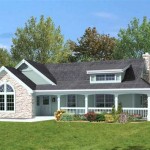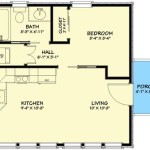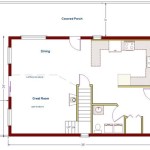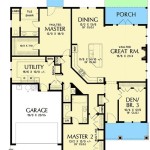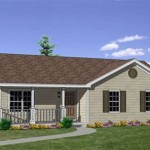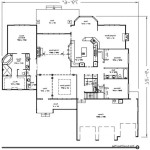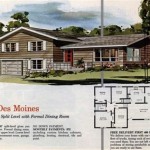Lake Home Plans With Basement: Enhancing Lakeside Living
Lake home plans with basements represent a unique intersection of architectural design and functional living. They cater to homeowners seeking to maximize usable space while capitalizing on the aesthetic and recreational opportunities afforded by lakeside properties. A basement in a lake home offers practical advantages ranging from storage to additional living areas, and can potentially enhance the overall value of the property. The considerations involved in designing and constructing a lake home with a basement differ significantly from those of standard residential construction due to the proximity to water and the specific geological conditions often found near lakes.
Planning a lake home with a basement requires careful assessment of the site's topography, soil composition, and water table level. The design phase must account for potential moisture intrusion, structural integrity, and compliance with local building codes and environmental regulations. The selection of materials and construction techniques is crucial for ensuring the longevity and resilience of the basement structure in a potentially challenging environment. Furthermore, integrating the basement seamlessly into the overall design of the lake home is essential for creating a cohesive and aesthetically pleasing living space.
Benefits of Incorporating a Basement in a Lake Home
The addition of a basement to a lake home provides a multitude of benefits that extend beyond simply increasing square footage. These advantages encompass practical considerations, lifestyle enhancements, and potential financial gains. A well-designed basement can transform a lake home into a multi-functional space tailored to the specific needs and interests of the homeowners.
One significant advantage of a basement is the provision of ample storage space. Lake homes often require storage for recreational equipment such as kayaks, paddleboards, fishing gear, and water skis. A basement offers a dedicated area to store these items securely and conveniently, reducing clutter in the main living areas. This is particularly valuable in smaller lake homes where space is at a premium.
A basement can also serve as a valuable secondary living space. It can be transformed into a recreation room, a home theater, a guest suite, or a home office. The possibilities are virtually limitless, and the added flexibility allows homeowners to customize their living environment to suit their individual needs and preferences. In addition, a finished basement can substantially increase the resale value of a lake home, making it a worthwhile investment.
Another benefit of a basement, especially in colder climates, is its role in improving energy efficiency. The earth surrounding the basement walls provides insulation, helping to regulate the temperature inside the home. This can lead to lower heating and cooling costs, contributing to long-term savings and a more sustainable living environment. Furthermore, a basement can serve as a safe haven during severe weather events, offering a protected space away from potential hazards.
Key Design Considerations for Lake Home Basements
Designing a basement for a lake home requires meticulous planning and attention to detail. Several critical factors must be considered to ensure the structural integrity, functionality, and long-term performance of the basement. These considerations extend beyond the typical requirements for residential basements and take into account the unique challenges posed by lakeside environments.
Waterproofing is paramount in lake home basement design. The proximity to water increases the risk of moisture intrusion, which can lead to structural damage, mold growth, and health problems. Implementing a comprehensive waterproofing system is essential to protect the basement from water damage. This system may include exterior waterproofing membranes, interior sealants, drainage systems, and sump pumps. Regular inspections and maintenance of the waterproofing system are crucial for ensuring its continued effectiveness.
Proper ventilation is also critical for maintaining a healthy and comfortable basement environment. Adequate ventilation helps to prevent the buildup of moisture and humidity, reducing the risk of mold growth and improving air quality. This can be achieved through the installation of windows, vents, and dehumidifiers. A well-ventilated basement is less prone to dampness and musty odors, creating a more pleasant living space.
The type of foundation and construction materials used in the basement are important considerations. Concrete is a common choice for basement foundations due to its strength and durability. However, it is important to use high-quality concrete that is resistant to water penetration. Other options include insulated concrete forms (ICFs), which provide excellent insulation and can simplify the construction process. The selection of construction materials should be based on the specific soil conditions, water table level, and climate of the lake home location.
Integrating the basement access into the overall design of the lake home is another key aspect. The access point should be convenient and aesthetically pleasing, seamlessly blending in with the surrounding landscape. Walk-out basements, where one or more walls are exposed to the exterior, are a popular option for lake homes. They provide natural light and easy access to the outdoors, blurring the lines between the interior and exterior spaces.
Addressing Potential Challenges in Lake Home Basement Construction
Constructing a basement in a lake home can present various challenges that require careful planning and execution. These challenges stem from the specific characteristics of lakeside properties, including soil conditions, water table levels, and environmental regulations. Overcoming these challenges requires expertise in construction techniques, a thorough understanding of local building codes, and a commitment to environmental stewardship.
One of the primary challenges is dealing with high water tables. The water table is the level below which the ground is saturated with water. If the water table is high, it can pose significant problems during basement construction, including water intrusion and structural instability. Solutions to this challenge include installing dewatering systems to lower the water table during construction, using waterproof membranes to seal the basement walls, and designing the basement to withstand hydrostatic pressure.
Soil composition is another important consideration. The soil around a lake home may be sandy, silty, or clayey, each of which presents unique challenges. Sandy soils are well-draining but may lack stability. Silty soils are prone to erosion and can hold water. Clayey soils are expansive and can exert pressure on basement walls. A geotechnical investigation is essential to determine the soil composition and to inform the selection of appropriate foundation and construction techniques. Soil stabilization techniques, such as compaction and soil replacement, may be necessary to ensure the long-term stability of the basement.
Compliance with environmental regulations is also crucial. Lakefront properties are often subject to strict environmental regulations designed to protect water quality and preserve natural habitats. These regulations may restrict construction activities, limit vegetation removal, and require the implementation of erosion control measures. It is important to consult with local authorities and obtain the necessary permits before commencing construction. Failure to comply with environmental regulations can result in fines, project delays, and even legal action.
Access to the construction site can also be a challenge, particularly in remote lakefront locations. Limited road access, steep slopes, and unstable terrain can make it difficult to transport materials and equipment to the site. Careful planning and coordination are essential to ensure that construction activities can be carried out efficiently and safely. This may involve using specialized equipment, such as barges or small excavators, and implementing traffic management plans to minimize disruption to the surrounding area.
Cost considerations are an integral part of any construction project, but they are especially important for lake home basements. The cost of constructing a basement can vary significantly depending on the size, design, and features of the basement, as well as the site conditions and construction challenges. It is essential to develop a detailed budget that takes into account all potential expenses, including excavation, waterproofing, concrete work, framing, electrical wiring, plumbing, and finishing. Obtaining multiple bids from qualified contractors is recommended to ensure that the project is completed at a fair price.
Proper planning, design, and construction are essential for creating a lake home basement that is both functional and aesthetically pleasing. By addressing potential challenges and implementing appropriate solutions, homeowners can enjoy the many benefits of a basement while preserving the natural beauty of their lakeside property. Collaboration with experienced professionals, including architects, engineers, and contractors, is highly recommended to ensure the success of the project.

Sloped Lot House Plans Walkout Basement Drummond

Dream Lake House Plans With Walkout Basement

Rustic Mountain House Floor Plan With Walkout Basement

Craftsman Style Lake House Plan With Walkout Basement

Lake Home Plans

Small Cottage Plan With Walkout Basement Floor

Plan 790026glv Exclusive 4 Bedroom Lake House With Walk Basement

Cedar Lake Mountain Home Plans From House

Mountain Lake Home Plan With A Side Walkout Basement 68786vr Architectural Designs House Plans

Luxe Lake House Plans From Visbeen Architects Houseplans Blog Com

